Behind the Scenes: What ACTUALLY Happens to Recycling
I love a good tour of a recycling facility or a landfill site. Asking the question “where does our rubbish and recycling actually go?” is one thing, but to actually go and have a look? That’s a completely different experience.
Recycling is presented to us as a green, clean solution – but the truth is, it’s stinky, resource-intensive and run by markets. Meaning, if it’s not cost-effective to recycle, then it won’t be recycled. If no-one wants to buy the stuff that we’re collecting for recycling, then it won’t be recycled.
My first visit to a recycling centre (which has the technical name of Materials Recovery Facility, or MRF – pronounced “murf”) was back in 2012. I’d just taken part in Plastic Free July, and was working hard to reduce my plastic and choose glass, paper and cardboard instead.
That MRF visit changed my perspective on waste almost as much as Plastic Free July did.
Because it didn’t look like how recycling looks like in the brochures.
Because it was kinda stinky and gross, and there was so much of it.
Because the guy showing us around was hell-bent on telling us: if we can’t sell it for good money, we send it to landfill.
This was the recycling from just a few suburbs collected in a single afternoon.
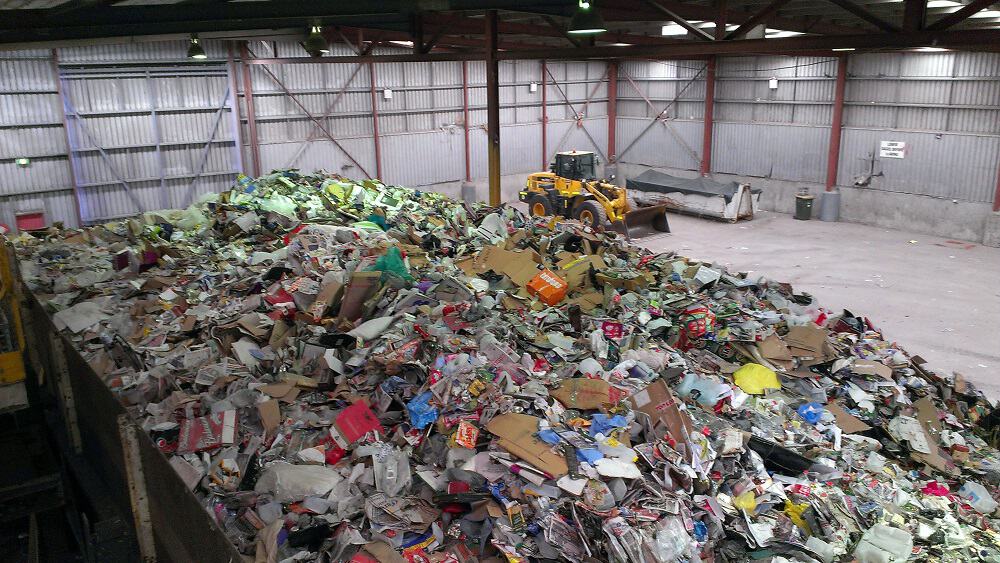
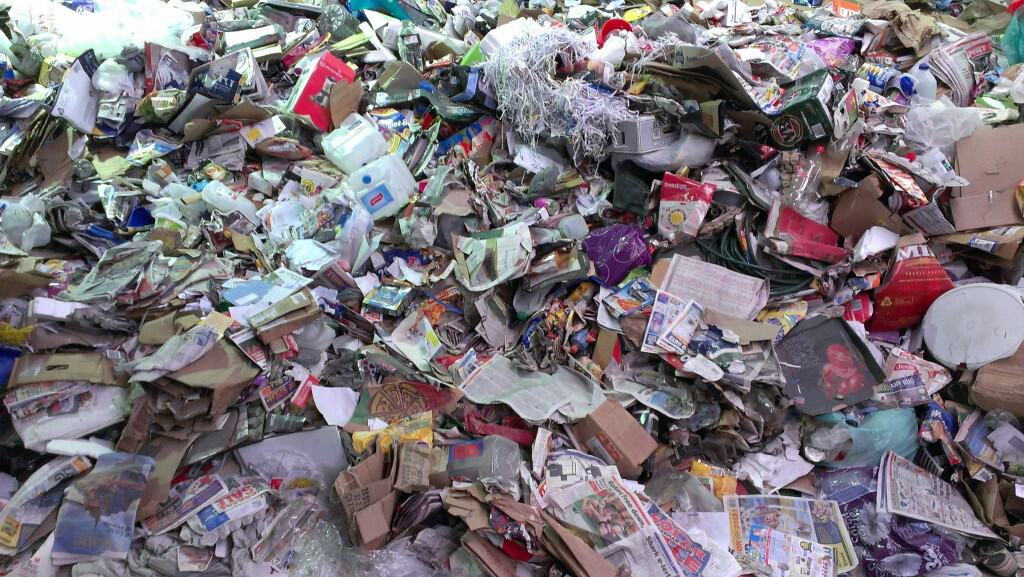
Visiting that MRF challenged my perceptions of recycling. It wasn’t green, or clean. It was a business, and it was running for profit. If landfill was a cheaper option than recycling, then the resources were landfilled. The ones that were recycled were baled into containers and shipped overseas for processing.
Everything went overseas for processing. None of that happened in Perth.
The biggest revelation for me was that glass is not recycled at all in Perth. Some MRFs sell glass to be crushed into road base (which I personally don’t consider to be recycling), but at this MRF, all glass was landfilled.
(Five years later and this is still true: glass is still not recycled in Perth, nor it seems, on the east coast of Australia.)
That visit to the MRF changed the way I viewed waste completely. There I was, choosing glass over plastic, only to find out that all that glass was heading to landfill.
That was not what I had expected.
That was my realisation that it wasn’t just plastic I needed to refuse, it was all packaging. I hadn’t heard of “zero waste” back then, but that visit was the start of my zero waste journey.
I’ve been pretty obsessed with waste ever since, and I’ve been to plenty of MRFs and other waste recovery places to find out exactly what goes on. I thought I’d share a few of these insights for those of you who can’t make it to one.
What Goes on at a Materials Recovery Facility (Recycling Centre)?
This is one of several recycling facilities in Perth. This facility services 5 councils. It cost $20 million to build.
The recycling is dumped on the floor by the recycling trucks, and from there is loaded onto a conveyor belt and the various recycling streams are sorted.
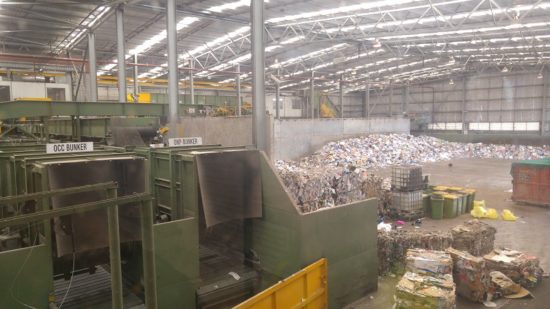
First the cardboard and paper is separated by spinning rollers into mixed paper, old corrugated cardboard and old newspaper (the three structures labelled in the picture below).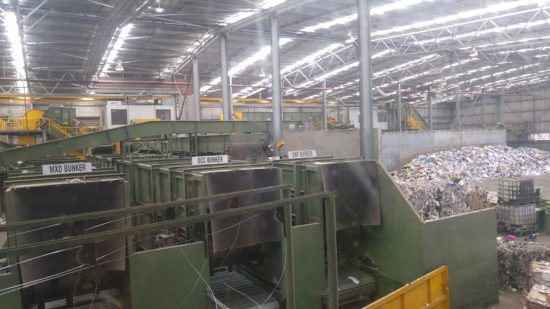
The glass is sorted by a tremel, crushed and used for road base. The steel is separated by a magnet, the plastic is sorted by an optical eye that can differentiate PET, HDPE and mixed plastic, and these are separated. An eddy current is used to separate the aluminium.
The resulting materials are baled and loaded into containers for shipping overseas: China, Malaysia or Indonesia. The recycling facility works on 3-month contracts with these purchasers.
What happens once these materials arrive overseas is a grey area. The companies have standards and agreements to adhere to for recycling and processing the waste, but there are also reports that most of the plastic is burned as a cheap alternative to fossil fuels.
What Happens with Commercial Composting?
Commercial composting can use various different “wastes” but for households, there are two main types of collection – those that use a dedicated food organics and garden organics bin (FOGO – they do love acronyms in the waste industry!) and those which compost the general landfill bin.
This facility composts the landfill bin. This means a much higher level of contamination.
Residents tend to put things in their landfill bin that they are told they cannot recycle. That makes sense, yes? But it means plastic, broken glass, pottery, broken electronics and all kinds of other stuff gets mingled in – and sent here for composting.
The first job is when the landfill waste arrives here is to remove as much of the big contaminants (bicycle wheels, gas bottles, large plastic items) from the waste. This is sorted with a big truck. Then it’s loaded into the composting machines, called digesters. They are 67m long, and there are 4 of them at this facility.
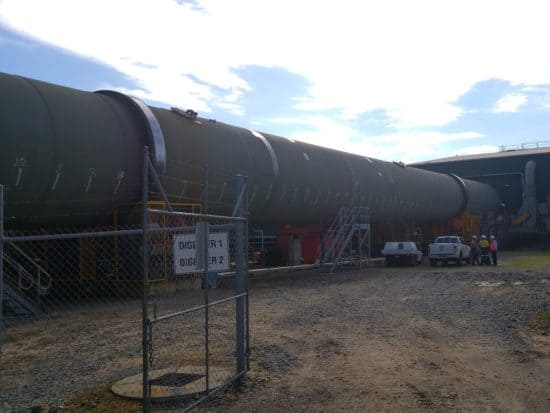
The “waste” is rotated in the digester for 3 days before being deposited in a large warehouse (the size of two soccer fields) to mature. It’s turned every few days by a machine, and cooled using giant fans to circulate air.
To prevent odours, the digesters have these enormous biofilters, made of tanks filled with water and wood chips. There are four of these: one for each digester. The air is sucked out with a vacuum filter. 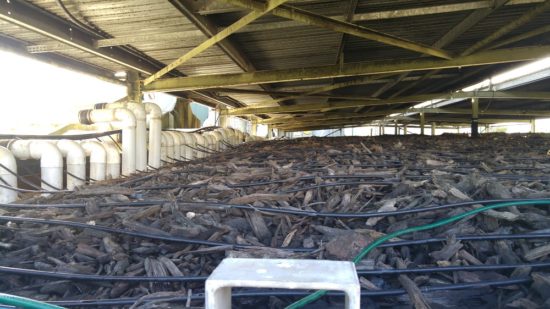
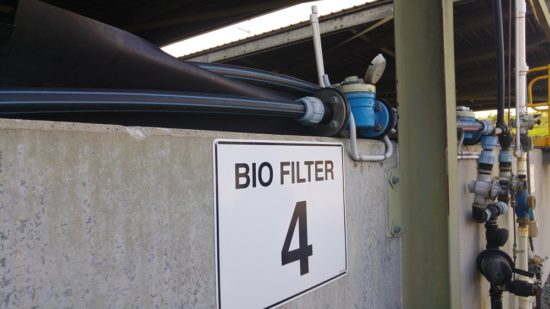
The compost is then sieved and screened to remove metal, plastic, glass and other pieces, and transported for further processing. Because it still has high levels of contaminants, it is only suitable for agricultural use.
Commercial composting facilities that accept dedicated food and garden organics bins have much lower levels of contamination and produce a higher grade compost.
Is This Typical? Is This What Happens to MY Recycling?
The truth is, every recycling facility is different. Some are much more high-tech than this, and some are much lower tech. Some use hand-pickers (real people who separate rubbish and pick out contaminants) and others rely solely on machinery.
Commercial composters are also different, and processes vary. Some councils don’t utilise these services at all, and simply landfill the contents of the landfill bin.
No two Materials Recovery Facilities are exactly the same. (Even where the machinery is the same, the contractors might be different, the ability to sell resources to markets is different, volumes will differ, and operating costs – meaning profitability -will be different.) If you are even the slightest bit interested in waste and where it goes, I recommend visiting your local one. Many (but not all) are open to the public. Contact your local council or waste contractor, and ask if they run tours.
Even if they don’t, there might still be an opportunity to have a look. Ask the question!
No Recycling Facility has 100% Recycling Rates
Recycling is always subject to contaminants, error and changes in the market. Someone putting the wrong thing in the wrong bin can contaminate a whole load (think asbestos and hazardous waste).
Markets change all the time. The value of plastic fluctuates with the price of oil. If oil prices are low, there’s less incentive for manufacturers to use recycled plastic as new plastic will be cheap. If oil prices are high, it’s more expensive to ship low-cost materials overseas for processing.
Councils often encourage us to put things into our recycling bins to get us into good habits. Or, they might prefer non-recycables to go to a recycling facility for sorting and removal, rather than putting them through a commercial composter (where they can do more damage). Or they think it is just too confusing to go into details, and we’ll get overwhelmed if they don’t make it really simple for us.
Acceptance of a material into a recycling bin is not a confirmation that the material will be recycled. It just means that it is the preferable option: to establish good habits, reduce contamination elsewhere, and give us faith in the recycling system.
Recycling Uses Huge Amounts of Energy
Recycling takes a huge amount of resources. Trucks need to collect those recycling bins from our streets, drive them to sorting facilities (and sometimes they get taken to a transfer station first, meaning two road trips) and then heavy machinery is required to sort the different streams. Then the materials need to be baled, loaded into containers and shipped to their final destination – which is often overseas.
Once overseas, there’s more processing and transportation.
Yes, recycling helps reduce new materials from being mined out of the ground. Yes, it uses less energy overall than making new things. Yes, it definitely keeps things out of landfill and keeps materials in circulation longer.
Recycling is definitely preferable to not recycling.
But recycling is not a perfect solution.Â
Recycling is not a get-out-of-jail-free card.
Refuse, rethink, reduce, reuse and repair – they all come before recycling.
Much as I’d love to live completely waste free, we don’t live in a circular economy. Many things are not designed for reuse. I still produce recycling – everyone does. I still receive letters in the mail, purchase the odd thing in paper or cardboard, buy wine in glass bottles on occasion, and find plastic packaging entering my home.
But I try to keep my recyclables to a minimum. If I can refuse something, then I will.
I pop those things I can’t (or choose not to) avoid in my recycling bin and I hope for the best.
Before I embarked on my zero waste lifestyle, I would see my full recycling bin as a badge of honour for being the responsible eco-citizen. Now I see anything that enters my recycling bin as a waste of resources, a failure of my imagination, a flaw in the system.
Most importantly, I see these things as something to work at improving for next time.
It is fantastic that recycling exists. It saves all those resources from landfill, and gives them the opportunity for reuse. We will always need recycling, but we mustn’t rely on it, or think of it as the solution.
Recycling is a great place to start. But it’s a terrible place to stop. We can do so much better.
[leadpages_leadbox leadbox_id=1429a0746639c5] [/leadpages_leadbox]

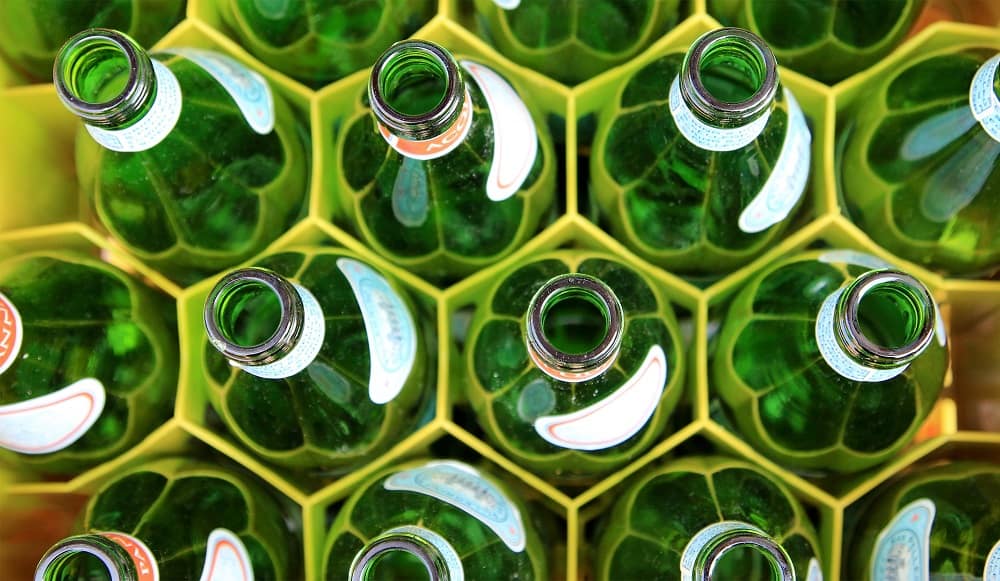




This was fascinating, Lindsay! I’ve never thought to ask my local council for a tour before. You’ve inspired me to ask! I’ve always known that recycling isn’t a perfect solution but didn’t realise just how resource-intensive it is. Absolutely agree that it is not a get-out-of-jail-free card but it has sometimes been promoted as such. Very interesting post!
Hi Alexis and thank you! Let me know what the council say. In my experience most here have some capacity to offer tours, even if they are not set up for it – especially if it is being arranged by the council. Looking forward to the update from you!
Did you see Four Corners last week? It was about recycling. It was so shocking I couldn’t watch it all! I had no idea glass wasn’t recycled here, and was dependent on markets. Will I have to give up alcohol?
Hi Melanie, yes I did. I didn’t know there was that level of corruption. I don’t know too much about the east coast set-up but I always assumed it was better than the west coast. Apparently not!
There’s more and more places popping up that sell bulk wine and beer, so keep your eye open!
Brilliant post! I think we seem to be under the impression that recycling is a “good” thing and if we can recycle we are doing OK but as you point out it really isn;t the answer when we should not be bringing into our homes anything that we can’t actually use up. The question we need to address is how that might be achieved both by us consumers and more importantly by the manufacturers and sellers of the stuff. Keep up the good work.
Thank you Jane :) I think in the 1980s when recycling became more mainstream and commonplace it was the “good” thing, now a few decades on we are starting to see the cracks. The good news is there are people on all sides working to make changes. It will happen!
Thank you so much for writing this Lindsay, it’s fascinating and I’m definitely motivated to visit my nearest recycling facility to find out more about UK practices too. It’s also always helpful to have a well researched article to assist in explaining to other people why recycling is not the be all and end all of being ‘green’.
Pleasure! I honestly think everyone should visit. There’s lots of general info out there, but going to the exact places and asking questions is always going to give a better insight. And I think you can never appreciate the scale unless you’re standing there surrounded by it all.
What a great article. Recycling has been presented to us as a way of continuing to consume and acquire things without the guilt of creating waste which would automatically go to landfill but, dependent on markets, it could still become landfill anyway :(
Thanks Nicola. You’ve got it exactly right, that’s what frustrates me about recycling so much. It’s the idea that we can overconsume and buy more than we need simply because we are allowed to put it in our recycling bin. It doesn’t address the key issue – we are living as if we have an extra planet of resources to fall back on, and we don’t! We just have this one.
Hi Lindsay,
I was also once proud of how much I recycled until I knew better, recycling is just a bandaid on a cancer, it is not the solution. Thanks for writing about this and also encouraging us to visit our local recycling centre. Have a lovely day.
Fi
Thanks for your comment Fiona – glad you’re inspired to visit a recycling centre! I think most of us on the zero waste path had a moment of proudness at all that recycling we’d produced. As I said, a great place t start, but… ;) I’m glad the conversation is starting to shift and we can see the other changes that can be made – often without too much effort. The tide is turning!
Great post! Love this!
Thanks Jessica :)
Recycling sucks. Great article!
Hehe, thanks Helmuth :)
Should we all be buying our drinks in aluminium? Apparently it has the highest market value of all recyclables.
Good question, Ann. Aluminium is still hugely resource-intensive to produce, but it is also one of the highest value items to recycle – meaning it does get recycled. I think where possible we can find alternatives – soda streams, refillable beer, homemade ginger beer etc. But where the choice is between glass, plastic and aluminium, aluminium is the least wasteful.
The other thing to know about aluminium cans is that they often lined with an epoxy resin and/or coated with BPA. So there are some health concerns which not everyone loves.
The path is never clear! I would say, reduce packaging as much as you can or find alternatives, and use aluminium where you can’t. That’s what my husband does (he drinks beer).
Hope that helps!
Very timely and thought-provoking post. Thank you Lindsay! I watched Four Corners report on the recycling industry last week and felt quite depressed and frustrated at the amounts of recyclables going in to landfill.I guess the take home message for all of us, is to try to avoid creating waste in the first instance, reuse as much as possible and become proactive in using our buying power to encourage manufacturers to create products where possible that do not leave a waste footprint.
Thanks Christine. I saw the show – it was good. I felt there was maybe an opportunity missed with the Four Corners show to give next steps to people frustrated with what they saw. It was great journalism and very insightful, but I didn’t think viewers were left with what to do next – and so everyone just felt angry and frustrated. Maybe that will drive action, but if they’d offered a call to action (write to your MP or whatever) it could have helped.
The TV is definitely making people think a little more about their waste!
Great article thank you. Just starting up a Repair Cafe in Horsham West Sussex and also trying to persuade our local Waste Recycling Centre (also known as the tip) to start a shop on site to recycle more things. It is a win win situation for them. Things are brought that would be thrown away – they are then sold and the money pays for the staff to run the shop and less items go into landfill. Surrey, Hampshire and other counties do it in the UK – can’t see why it could not work here.
That’s great Jill – on both counts! The two landfills I’ve been to here both have tip shops and I know there’s another council working on establishing one at another site, so yes – it can be done!
Good luck with both your projects and keep me updated with how it is all going :)
Great post. I’ve been trying to highlight similar issues here in Ireland. Political parties, even the Green Party, and the waste industry keep touting recycling as the solution whuch often brings us further away
Hi Elaine! The waste industry will always tout recycling as a solution because they are protecting their interests – the more stuff they can recycle, the more profit they make. And political parties are always supportive of industry, it seems.
It is frustrating, but keep doing what you can, and know that change is coming! :)
zero waste
It’s all getting so confusing and complicated. After 10 years in my unit, I have been inspired to do a mini reno in my bedroom. I found a squeaky new ‘offcut’ of wool and yak carpet on gumtree slightly larger than my bedroom. I did the demo in line w my local Council cleanup. It is always traumatic to see all that stuff lined up for landfill and we are no longer allowed to put stuff out early for others to collect before the trucks. I managed to get the wardrobe metal door frame and tracks picked up for recycling and someone took the particle board wardrobe floor. I failed to divert the carpet, underlay, and internal bits of the wardrobe doors, now off to landfill. I have also kept the internal wardrobe wood to hopefully divert for someone to use for upcycling and / or firewood, I just couldn’t put it out for landfill. As the only storage in my unit outside the kitchen, I do need to maximise use of the bedroom wardrobe space, but have decided that instead of built in drawers, I will find an antique dresser to fit in one section. I am looking on gumtree for other things to update / fix other parts of my unit. I have found a couple places that may be possibilities for upcycled timber floor boards. Would be keen to know about any tips, sites, or tricks for low-cost, low skill, low impact mini renovations (I have no interest in a complete gut- white 60s bathroom and 80s kitchen are generally ok).
Hi Mel! I have zero experience in renos of any kind, but I am thinking like you – less “built-in” and more pieces that can be moved, removed or altered. We have a huge wardrobe in our spare room, built-in, and I hate it. It’s enormous and we just don’t have the stuff to put in it. And without it, the room would be much nicer. But to rip it out would mean trashing it (the runner bit is glued to the floor, there’s a panel on the side with loads of cables hidden underneath) so now I’m thinking, a set of drawers inside. There’s nowhere in the actual room to put any furniture except the bed because there’s all these doors. Drives me nuts. And of course, our place is new, so ripping anything out because its poorly thought out and impractical is a waste of resources So I bite my lip…
I looked into my local recycling and the picture is a bit better – but doesn’t negate the need to reduce and reuse rather than recycle. In case you’re interested – https://www.brighton-hove.gov.uk/content/environment/recycling-rubbish-and-street-cleaning/what-happens-your-recycling
Hi Jeanne, thanks for sharing! Europe is much better set up for recycling (by which I mean, more markets)! We have only 20 million people in Australia, and only 1.3 million in Perth, versus 70 million in the UK. It means there are more options, which is a good thing. But let’s not get complacent… ;)
Upon reading all the foregoing comments, I would like to make a couple of my own.
Ultimately, society needs to make manufacturers create only products that can be recycled.
We also need to have a definite system for the recycling—just leaving it to the end user will not work. There needs to be an incentive for end users to recycle.
Manufacturers must accept responsibility for their old product when it is no longer used.
There will be huge resistance to this, but it is slowly happening with some products.
Another point is that recycling automobiles for example does not mean simply crushing them up and exporting to a third world country to be melted down. It should mean doing what BMW does–disassemble parts into common materials.
People don’t realize how much fossil fuel is being consumed in the process of recycling. IT IS MASSIVE AMOUNTS. This fossil fuel is consumed both in the transportation, and the electric power, and natural gas consumption needed to operate, maintain, and staff all those recycling facilities. Fossil fuels are consumed in massive amounts that they otherwise wouldn’t be by the trucks that pick up the recycling on a separate schedules from the refuse trucks, by the heavy machinery that move the materials around and gets them to the appropriate machines, by the machines that sort and process the materials, by the trucks that move the materials to the shipping facilities, by the trucks and cranes that move the materials onto the ships, and(in the largest way) by the ships that send the materials across vast oceans of water to foreign lands, A container ship can easily burn through 120 gallons of diesel fuel for every mile they travel on water. On average, China/Malaysia/Indonesia, are between 6500 and 8500 miles from Los Angeles. That equates to the burning of somewhere between 80000 to 1 MILLION gallons of diesel fuel for every container ship of recycled plastic that is shipped to Asia!!!! THEN, MORE fossil fuels are burned by the trucks that move the materials off the ships, by the machines that move the materials into the processing facilities overseas, and by the facilities themselves that use the recycled materials. If those countries are indeed burning those plastics, and not turning them into more plastic products, then how can that be good for the environment???? Even if the combustion outputs are filtered, it’s NOT GOOD! And we all know that the environmental restrictions in the Asian countries that are taking these plastics and burning them are nil to none. It is doubtful that they even worry about the harm that they are doing to the environment by burning plastics into the open air. They do everything as cheaply as they can get away with over there. Every recycling program that I’ve ever read about had to be subsidized by local governments. They are not self-sustaining, or beneficial. They do give recyclers and consumers the false appearance of doing something positive with their trash, but that’s about it. It makes some people feel good about throwing their trash away ‘properly’, but that’s all that these recycling programs do. They are not cost efficient, and are more harmful to the environment than just burying the trash in the ground.
In my own area (Vancouver Island), it was publicly announced last summer that plastic is no longer being sent overseas for reycling, and that was followed shortly thereafter by more than a couple of news stories about what really happens with our crap over there – as you described – often burned or just landfilled there. But the blue box programme continues to encourage us to put certain plastics into it, and the monthly mobile depot that takes soft plastics, styrofoam etc (for a fee) is still going strong. I think you’re right – they’re trying to instill us with good habits, but heaven knows where the stuff is going. I visit the recycling centre up the local landfill 2 or 3 times a year – it is largely self serve – big dumpsters with steps for accessiblity where you deposit your paper/tins/bottles/etc and a long open shed with a couple of staff where they take things like household quantities of hazardous chemicals (bottles of weed kiler etc), old fire extinguishers, paint, light bulbs, electronics etc. In conversation with staff over the years I’ve learned that, as you say, this is about keeping it out of the landfill. Although both my kids have been on numerous tours at the landfill with school over the years, I have never been. I’m going to book on one right now!